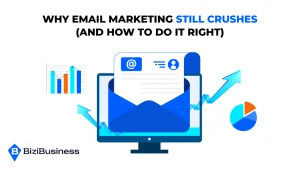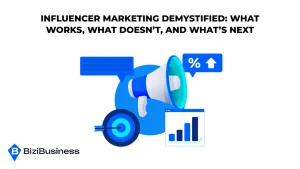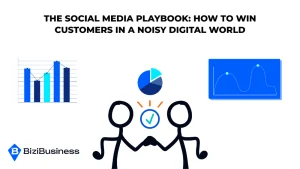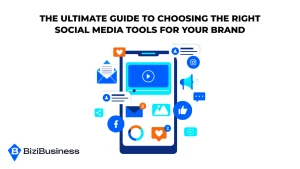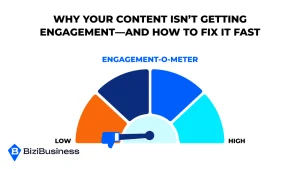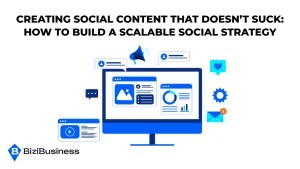BiziTopics
Stop Wasting Budget: How to Strategize Your Paid Ad Campaigns
BiziBusiness
Jul 8, 2025
21 min read
Paid advertising can be a powerful way to drive traffic, generate leads, and boost sales.
But without a strategic plan, it can also become a costly experiment.
Many businesses dive into paid ads without proper planning, resulting in budget waste and disappointing ROI.
The solution? Start with a solid paid ad strategy that aligns with your business goals and audience.
From setting clear objectives to choosing the right platforms and monitoring performance, strategic planning ensures your budget is spent efficiently and effectively.
By the end of this guide, you’ll be equipped to strategize your paid ad campaigns like a pro—maximizing results while minimizing wasted spend.
Let’s get started.
Why Planning Your Paid Ad Strategy Matters
Jumping into paid ads without a plan? You’re setting yourself up for budget waste.
Launching a paid ad campaign without proper planning is like throwing darts in the dark—you might hit the target, but most of your shots will miss the mark.
Without a strategic foundation, your ads can easily become inefficient, costly, and ineffective.
Here’s why planning your paid ad strategy is essential:
Avoiding Budget Waste: Spend Smart from the Start
One of the most common mistakes in paid advertising is allocating budget without a clear plan.
When you fail to define your objectives and strategy upfront, you risk spending on ineffective channels or unqualified audiences.
Why Planning Helps:
- Ensures your budget is aligned with specific goals (like lead generation or sales).
- Helps identify high-impact platforms rather than spreading your spend too thin.
- Allows you to set realistic performance benchmarks from the outset.
Data-Driven Decisions: The Power of Insightful Planning
Planning allows you to leverage data rather than relying on gut instincts.
By analyzing past campaign performance and industry benchmarks, you can make informed choices rather than trial-and-error guesses.
How to Plan Data-Driven Campaigns:
- Review historical data to understand what worked (and what didn’t).
- Use insights to fine-tune your targeting and ad creative.
- Establish KPIs that directly relate to your campaign objectives.
Setting Clear Objectives: Know What Success Looks Like
Every paid ad campaign should have a specific goal—whether it’s brand awareness, lead generation, or driving sales.
Planning helps you define SMART objectives (Specific, Measurable, Achievable, Relevant, Time-bound) to guide your campaign.
Why This Matters:
- Keeps your campaign focused on measurable outcomes.
- Avoids vague goals like “get more traffic” by specifying how much and by when.
- Aligns your team around clear expectations for performance.
Streamlining Campaign Execution: Stay Organized and Efficient
Planning isn’t just about setting goals—it’s about organizing your efforts to achieve them efficiently.
By structuring your campaign from the start, you avoid the chaos of last-minute adjustments and reactive decision-making.
How to Streamline:
- Develop a campaign calendar that outlines when and where ads will run.
- Pre-plan ad variations to accommodate A/B testing.
- Set up tracking systems before launching to capture key metrics from day one.
Anticipating Challenges: Be Prepared for the Unexpected
Paid ad campaigns rarely go exactly as planned.
By anticipating potential challenges, you can build contingency plans into your strategy, saving you from scrambling when problems arise.
Common Challenges to Plan For:
- Ad Fatigue: Rotate creatives to keep engagement high.
- Budget Overruns: Set spending limits to avoid blowing your budget.
- Platform Changes: Stay updated on ad policy changes that could affect your campaign.
- Performance Drops: Identify quick-fix options like changing targeting or adjusting bids.
Setting Clear Objectives: Know What You Want to Achieve

One of the most common reasons paid ad campaigns fail is the lack of well-defined objectives.
If you don’t know what success looks like, how can you measure it?
Setting clear, measurable goals helps you focus your efforts, allocate resources efficiently, and evaluate your campaign’s effectiveness.
Here’s how to set goals that keep your paid ad campaigns on track and successful.
The Importance of Defining Campaign Goals
Launching a paid ad campaign without specific goals is like going on a road trip without a destination.
You may move forward, but you’re not sure where you’re heading or how to get there.
Why Goal Setting Matters:
- Guides your creative direction and messaging.
- Helps determine budget and resource allocation.
- Enables accurate performance tracking and optimization.
- Aligns your team around a common purpose.
Setting SMART Goals: Make Them Clear and Achievable
SMART goals are:
- Specific: Clearly define what you want to achieve.
- Measurable: Use metrics to track progress.
- Achievable: Set realistic targets based on available resources.
- Relevant: Align with your broader business objectives.
- Time-bound: Set a deadline for achieving the goal.
Matching Objectives with Campaign Types
Different campaign goals require different ad strategies and metrics.
Choosing the right type of campaign helps you focus on the right outcomes.
Common Campaign Types and Their Objectives:
| Campaign Type | Primary Objective | Key Metrics |
|---|---|---|
| Brand Awareness | Maximize visibility | Impressions, Reach, CPM |
| Lead Generation | Collect customer information | CPL, Conversion Rate |
| Sales/Conversions | Drive purchases or sign-ups | ROAS, CAC, Conversion Rate |
| Traffic | Bring visitors to your site | CTR, CPC, Bounce Rate |
| Engagement | Increase interaction | Likes, Comments, Shares, CTR |
| App Installs | Increase mobile app downloads | CPI, Install Rate, User Retention |
Aligning Goals with Business Objectives
Paid ad goals should always tie back to your overall business strategy.
If your business priority is to expand your customer base, focus on lead generation rather than just traffic.
If your main aim is to boost revenue, prioritize sales-focused campaigns.
Revisiting and Adjusting Goals
Sometimes, your initial goal may not align with how your campaign actually performs.
It’s essential to reassess and adapt as you gather more data and insights.
How to Adjust Goals:
- Use initial performance data to recalibrate expectations.
- Be flexible—if your CTR is consistently low, focus on improving ad copy or targeting.
- Shift your objective if market conditions change (e.g., during a product launch or holiday season).
By setting well-defined goals, you create a roadmap for your campaign, ensuring every dollar spent contributes to your business’s success.
Remember, the clearer your objectives, the more focused your strategy will be.
Audience Targeting: Reaching the Right People

No matter how compelling your ad is, it won’t deliver results if it’s shown to the wrong audience.
Poor audience targeting leads to wasted budget, low engagement, and disappointing results.
By focusing your ad spend on the most relevant users, you maximize your ROI and increase the chances of achieving your campaign goals.
Effective audience targeting is crucial to ensure that your paid ads are seen by the right people—those who are most likely to engage, convert, or purchase.
Identifying Your Ideal Customer Profile (ICP)
Before you can target effectively, you need to know who your ideal customer is.
An Ideal Customer Profile (ICP) is a detailed description of the kind of customer who would benefit most from your product or service.
How to Create Your ICP:
- Demographic Data: Age, gender, location, income, education
- Behavioral Data: Online habits, buying patterns, interests
- Psychographic Data: Values, lifestyle, pain points, motivations
- Firmographic Data (for B2B): Company size, industry, job role
Example:
If you’re running ads for a fitness app, your ICP might include:
- Age: 18-35
- Interests: Fitness, wellness, tech gadgets
- Behavior: Regular gym-goers, follows fitness influencers
- Location: Urban areas with higher gym density
Leveraging Audience Data from Existing Campaigns
Your previous campaigns are a goldmine of insights.
By analyzing past performance, you can identify audience segments that consistently deliver results.
What to Look For:
- Demographic Performance: Which age group or gender had the highest CTR or conversion rate?
- Device Usage: Are mobile or desktop users more likely to engage?
- Location Data: Are certain regions performing better than others?
- Ad Interactions: Which audiences responded best to specific creatives or CTAs?
Creating Custom Audiences: Personalize Your Approach
Custom audiences allow you to reach people who have already interacted with your brand.
These audiences are often warmer leads, making them more likely to convert.
Types of Custom Audiences:
- Website Visitors: Target people who visited your site but didn’t convert.
- Email Lists: Reach subscribers with exclusive offers or updates.
- Social Media Engagers: Reconnect with users who liked, shared, or commented on your posts.
- App Users: Target people who installed or used your app recently.
Exploring Lookalike Audiences: Scale Your Reach
Lookalike audiences help you find new users who share characteristics with your existing customers.
Platforms like Facebook and LinkedIn use machine learning to identify similar users.
How to Create Lookalike Audiences:
- Upload a customer list or use data from website visitors.
- Choose the percentage of similarity (e.g., top 1% of similar users).
- Specify location and demographic filters to narrow the reach.
Utilizing Advanced Targeting Techniques
Going beyond demographics and interests, advanced targeting lets you drill down into behavior and intent.
Techniques to Try:
- Behavioral Targeting: Target based on recent online behavior, like searching for related products.
- Contextual Targeting: Place ads on websites related to your product or service.
- Geo-Targeting: Narrow your audience to specific locations or regions.
- Time-Based Targeting: Schedule ads during peak engagement hours.
Budget Allocation: Spending Smart, Not Hard
One of the biggest challenges in paid advertising is figuring out how much to spend and where to spend it.
Your ad budget is a finite resource.
Poor budget allocation can lead to wasted ad spend, low ROI, and underperforming campaigns.
On the other hand, a well-planned budget ensures that your funds are directed towards high-impact channels and audiences.
Here’s how to plan your paid ad budget wisely and make every dollar count.
1. Setting a Realistic Ad Budget: Know Your Limits
Your ad budget should be based on your goals, available resources, and expected ROI.
Spending too little might not generate results, while overspending without a plan can deplete your resources.
How to Set Your Budget:
- Start with Your Goals: Define what you want to achieve (e.g., 1,000 leads, $10,000 in sales).
- Calculate Cost Per Acquisition (CPA): Estimate how much you’re willing to pay to acquire one customer.
- Factor in Platform Costs: Ad costs vary by platform—Facebook vs. Google Ads, for instance.
- Consider Your Industry: Some industries (like finance or law) have higher CPCs than others.
- Allocate for Testing: Dedicate a portion (e.g., 20%) of your budget to experimentation and A/B testing.
2. Divide Your Budget Across Platforms: Avoid Putting All Eggs in One Basket
Choosing the right platforms to allocate your budget can make or break your campaign’s success.
Instead of focusing solely on one channel, diversify based on your audience behavior and campaign objectives.
Budget Distribution Tips:
- High Intent Platforms (Google Ads): Allocate more for search ads if users actively seek your product.
- Social Engagement (Facebook, Instagram): Invest in visual and interactive ads for brand awareness.
- Professional Networks (LinkedIn): Higher costs but valuable for B2B targeting.
- Niche Platforms (Reddit, Pinterest): Lower CPC but niche-specific reach.
3. Balancing Experimentation with Proven Strategies
While it’s tempting to put your entire budget into strategies that have worked in the past, this approach can lead to stagnation.
Allocating a portion of your budget to testing new ideas ensures you keep evolving and adapting to trends.
How to Balance:
- 80/20 Rule: Spend 80% on proven strategies and 20% on new tests.
- Test One Variable at a Time: To identify what works, isolate changes (e.g., ad format or targeting).
- Monitor Test Performance Closely: Be ready to scale successful tests and phase out failures.
4. Adjusting Your Budget Based on Performance: Stay Agile
Successful budget allocation isn’t static—it requires continuous optimization.
As your campaign progresses, you may need to reallocate funds based on performance data.
When to Adjust:
- Consistent Underperformance: Shift budget away from campaigns that repeatedly fail to meet KPIs.
- Seasonal Changes: Increase spending during peak periods (e.g., holidays).
- New Data Insights: If a new ad format performs well, scale up investment.
- Ad Fatigue: Reduce spend on creatives that are losing engagement.
5. Tools for Budget Allocation and Tracking
Managing your ad budget efficiently requires the right tools to track spend and performance in real-time.
Recommended Tools:
- Google Ads Budget Report: Track daily spending and project monthly costs.
- Facebook Ads Manager: Set budget limits and monitor cost per result.
- HubSpot Ads Add-On: View multi-channel ad performance and ROI.
- AdEspresso: Manage budgets across multiple social platforms.
- Supermetrics: Consolidate ad spend data from various sources.
Pro Tip:
Set up automated alerts in these tools to notify you when spending exceeds your planned limits.
Choosing the Right Platforms: Where Should Your Ads Appear?
Not every platform suits every campaign—choose wisely.
Choosing the right ad platforms is critical to your campaign’s success.
Different platforms attract different audiences and support different ad formats.
Placing your ads on the wrong platform can lead to low engagement, wasted budget, and disappointing results.
Why does this matter?
Each platform has unique strengths, audiences, and ad types.
Aligning your platform choice with your campaign goals ensures your ads are seen by the right people at the right time.
Here’s how to select the best platforms for your paid ad strategy.
Start with Your Audience: Where Do They Spend Time?
Your audience’s demographics and behaviors should guide your platform selection.
Choosing a platform without understanding your audience’s habits is like advertising in the wrong city.
Key Questions to Ask:
- Who are your customers? (Age, gender, interests)
- Where do they hang out online? (Social media, search engines, niche sites)
- What type of content do they engage with? (Videos, articles, infographics)
- What devices do they use? (Mobile vs. desktop)
Consider Your Campaign Goals: What Are You Trying to Achieve?
Different platforms serve different advertising objectives.
Your goal—whether it’s brand awareness, engagement, lead generation, or sales—should determine where you advertise.
Goal-Platform Match:
| Campaign Goal | Best Platforms |
|---|---|
| Brand Awareness | Facebook, Instagram, YouTube |
| Lead Generation | LinkedIn, Google Search, Facebook |
| Sales/Conversions | Google Shopping, Instagram, Amazon |
| Engagement | Twitter, TikTok, Instagram |
| B2B Marketing | LinkedIn, Twitter, Google Search |
| Local Targeting | Google Local Ads, Facebook, Yelp |
Leverage Platform Strengths: Play to Each Network’s Advantage
Each platform has unique features that can boost your campaign’s success when used correctly.
Platform Highlights:
- Google Ads: Great for intent-driven search traffic and remarketing.
- Facebook Ads: Ideal for targeting diverse audiences with visual and video content.
- Instagram Ads: Best for aesthetic and lifestyle brands—leverages Stories and Reels.
- LinkedIn Ads: Perfect for B2B and professional targeting.
- Twitter Ads: Great for real-time engagement and trending topics.
- YouTube Ads: Captures attention through visual storytelling and tutorials.
- Pinterest Ads: Ideal for DIY, fashion, and lifestyle inspiration.
- TikTok Ads: Engages younger audiences with creative video content.
Multi-Channel Strategies: Don’t Rely on Just One Platform
Relying on a single platform is risky.
A multi-channel strategy helps you reach audiences at different stages of the buyer’s journey.
How to Implement:
- Combine search ads on Google with social ads on Facebook.
- Use YouTube for awareness and retarget with display ads on other sites.
- Create cross-platform campaigns that carry a consistent message but adapt to each channel.
Crafting Compelling Ad Creatives: Make Your Message Stick

Even with the right audience and platform, your paid ad campaign can fall flat if your creatives don’t resonate.
A well-crafted ad creative grabs attention, sparks interest, and drives users to take action.
But with so much competition for attention, how do you make your message stick?
Here’s how to create ad creatives that not only catch the eye but also compel users to act.
1. Write Engaging Ad Copy: Hook Them from the Start
Your ad copy needs to be clear, concise, and persuasive.
People skim through content quickly, so your text should grab attention within the first few words.
Best Practices:
- Start with a Hook: Use a question, bold statement, or statistic to intrigue your audience.
- Be Specific: Avoid vague language—mention exactly what users will get.
- Use Action-Oriented CTAs: Encourage users to click, shop, sign up, or learn more.
- Focus on Benefits: Highlight how your product or service solves a problem.
- Maintain Brand Voice: Whether witty, professional, or conversational, keep your tone consistent.
Example:
- Hook: “Tired of ads that don’t convert?”
- Benefit: “Our proven strategies maximize your ROI.”
- CTA: “Start your campaign today!”
2. Design Visually Impactful Ads: Make Them Stop Scrolling
The visual element of your ad is often what draws users in.
Great visuals are eye-catching, relevant, and aligned with your brand’s aesthetic.
Tips for Visuals:
- High-Quality Images: Use clear, crisp visuals that represent your product or service.
- Bold Colors: Choose colors that stand out without being overwhelming.
- Minimal Text: Keep text on images to a minimum—let the visual do the talking.
- Brand Consistency: Use your brand colors, logo, and consistent typography.
- Visual Hierarchy: Make the headline and CTA prominent.
- Dynamic Elements: Incorporate motion graphics or GIFs for better engagement.
3. Use Video Creatives: Tell a Story in Seconds
Video ads are proven to drive higher engagement, especially on platforms like Facebook, Instagram, and TikTok.
Videos allow you to demonstrate product features, tell stories, or show behind-the-scenes content.
Video Ad Tips:
- Keep It Short: Aim for 15-30 seconds for most platforms.
- Front-Load Value: Capture attention in the first 3 seconds.
- Include Subtitles: Many users watch videos without sound.
- Show, Don’t Just Tell: Use visuals to demonstrate your message.
- End with a CTA: Clearly state what the viewer should do next.
Example:
A fitness brand runs a 15-second video ad showcasing a new workout routine with quick cuts, upbeat music, and a CTA: “Start Your Free Trial Today.”
4. A/B Test Your Creatives: Find Out What Works Best
Even the most well-crafted ad may not perform as expected.
A/B testing allows you to compare different creatives to see which resonates most with your audience.
What to Test:
- Headlines: See if a question performs better than a statement.
- CTA Text: Compare “Shop Now” vs. “Get Yours Today.”
- Visual Format: Test static images against animated graphics.
- Ad Length: Try short vs. longer videos.
- Color Schemes: Bold and vibrant vs. muted and minimalist.
5. Incorporate a Clear and Powerful CTA: Guide Your Audience
Your CTA tells users exactly what you want them to do next.
Without a clear CTA, even the most visually appealing ad may leave users confused or passive.
CTA Tips:
- Be Direct: Use action words like “Buy,” “Learn,” “Discover,” or “Try.”
- Create Urgency: “Limited Time Offer” or “Act Now” encourages immediate action.
- Match the Goal: Use “Sign Up” for lead generation or “Shop Now” for e-commerce.
- Make It Visible: Place the CTA prominently in your ad layout.
Example:
“Don’t Miss Out—Subscribe Today for 50% Off!”
Structuring Your Campaigns: Organize for Success

Paid ad campaigns can quickly become disorganized and hard to manage, especially when you’re running multiple ads across various platforms.
A structured approach not only makes it easier to track performance, but also helps you optimize more efficiently.
Break Down Your Campaigns by Goal: Start with the Objective
Every campaign should be aligned with a specific goal.
Structuring campaigns based on objectives ensures that each one is tailored to a particular outcome.
Common Goal-Based Campaign Structures:
- Brand Awareness: Campaigns focused on impressions and reach
- Lead Generation: Campaigns aimed at collecting emails or sign-ups
- Sales/Conversions: Campaigns designed to drive purchases
- Engagement: Campaigns to increase likes, shares, or comments
- Traffic: Campaigns to boost website visits
Group Ads by Audience Segment: Stay Targeted
Your audience isn’t a one-size-fits-all group.
Creating ad groups based on specific audience segments allows you to tailor your messaging and increase relevance.
How to Structure by Audience:
- Demographic Groups: Age, gender, income
- Behavioral Segments: Interests, past purchase behavior
- Geographic Location: Cities, states, or regions
- Customer Journey Stage: New visitors vs. returning customers
- Device Type: Mobile users vs. desktop users
Organize by Product or Service Category: Keep Offers Distinct
If your business offers multiple products or services, grouping your campaigns accordingly helps avoid confusion.
Each category should have dedicated campaigns and ad groups.
How to Structure by Category:
- E-commerce Example:
- Campaign 1: Men’s Footwear
- Campaign 2: Women’s Footwear
- Campaign 3: Kids’ Footwear
- Service-Based Example:
- Campaign 1: SEO Services
- Campaign 2: Content Marketing
- Campaign 3: Social Media Management
Structure for A/B Testing: Compare Variations Easily
Effective campaign structuring allows you to test different variables without overlap or confusion.
Separate your test variations within ad groups for clear comparison.
A/B Testing Structure:
- Ad Group A: Video Ad with CTA “Shop Now”
- Ad Group B: Image Ad with CTA “Learn More”
- Ad Group C: Carousel Ad featuring multiple products
- Campaign Objective: Sales/Conversions
Use Hierarchical Naming Conventions: Stay Organized
Name your campaigns, ad groups, and ads systematically to avoid confusion when analyzing performance.
A consistent naming structure makes it easy to filter and sort data.
Recommended Format:
- Campaign Name: [Goal][Platform][Product/Service]_[Month/Year]
- Example: LeadGen_Facebook_CRMSoftware_Apr2025
- Ad Group Name: [Audience]_[Ad Type]
- Example: Professionals_VideoAd
- Ad Name: [Creative Variation]_[CTA]
- Example: ExplainerVid_SignUpNow
Automate Campaign Structuring: Save Time and Reduce Errors
Using automated tools helps maintain consistency, especially for large-scale campaigns.
Platforms like Google Ads Editor and Facebook Ads Manager allow you to duplicate, adjust, and optimize campaigns easily.
Automation Tips:
- Use bulk editing to update multiple campaigns at once.
- Set up naming templates to standardize your structure.
- Automate bid adjustments and budget shifts based on performance data.
Monitoring and Analyzing Performance: Stay on Top of Your Results
You can’t improve what you don’t measure—track your ads with purpose.
Even the most well-planned and structured ad campaigns can fail if you don’t actively monitor performance.
Analyzing your ad data helps you understand what’s working, what’s not, and where to make adjustments.
Instead of guessing, you make data-driven decisions that maximize your ROI.
1. Setting Up Tracking: Capture Data from Day One
Tracking your ad performance starts with setting up the right tools before you launch.
If you skip this step, you’ll miss critical data and have no basis for evaluating success.
Must-Have Tracking Tools:
- Google Analytics: Track website traffic, goals, and conversion rates.
- Facebook Pixel: Monitor user interactions from Facebook and Instagram ads.
- Google Tag Manager: Manage and deploy marketing tags on your website.
- UTM Parameters: Track specific ad campaign performance in Google Analytics.
- LinkedIn Insight Tag: Capture data from LinkedIn ad engagements.
- Third-Party Dashboards: Tools like Supermetrics or HubSpot for consolidated reporting.
2. Establishing Key Performance Indicators (KPIs): Measure What Matters
Not all metrics are equally important.
Focusing on the wrong metrics can lead to misguided optimizations and wasted budget.
Identify KPIs that directly relate to your campaign goals.
Goal-Based KPI Examples:
| Campaign Goal | Key Performance Indicators (KPIs) |
|---|---|
| Brand Awareness | Impressions, Reach, Ad Recall, CPM |
| Lead Generation | CPL (Cost Per Lead), Conversion Rate, CTR |
| Sales/Conversions | ROAS (Return on Ad Spend), CAC (Customer Acquisition Cost), Sales Volume |
| Engagement | Likes, Shares, Comments, Video Views |
| Traffic | Clicks, CTR, Bounce Rate, Average Session Duration |
3. Analyzing Real-Time Performance: Be Proactive, Not Reactive
Waiting until the end of a campaign to analyze data is a missed opportunity.
Real-time monitoring allows you to spot problems early and make adjustments before your budget is wasted.
Metrics to Monitor Daily:
- Spend: Ensure you’re not exceeding your daily budget.
- CTR (Click-Through Rate): See how engaging your ad is.
- CPC (Cost Per Click): Monitor efficiency in acquiring clicks.
- Conversion Rate: Check how well clicks are translating into actions.
- Frequency: Watch for ad fatigue if users see your ad too often.
4. Comparing Ad Variations: A/B Testing for Continuous Improvement
Even after choosing a creative that works, there’s always room for optimization.
A/B testing helps you identify subtle changes that can improve performance.
What to Test:
- Headlines: Test different messaging styles.
- CTAs: “Buy Now” vs. “Shop Today.”
- Ad Format: Carousel vs. single image.
- Targeting Options: Different age groups or geographic locations.
- Landing Pages: Test variations for better post-click engagement.
5. Generate Reports and Analyze Trends: Look at the Big Picture
Individual data points are useful, but trends show how your campaign is evolving.
Generate reports to track weekly and monthly progress.
What to Include in Reports:
- Performance Metrics: CTR, CPC, ROAS, engagement rates
- Trend Analysis: Compare week-over-week or month-over-month data
- Audience Insights: Who’s responding most positively?
- Creative Performance: Identify top-performing visuals and copy
- Budget Utilization: Track where your spend is most effective
When you monitor your paid ad campaigns effectively, you make data-driven decisions that save budget and improve results.
Strategize, Optimize, Succeed
Mastering paid ad strategy and planning is about being intentional and adaptive.
Start by defining clear objectives, choosing the right platforms, and crafting engaging creatives.
Structure your campaigns thoughtfully, monitor performance actively, and keep optimizing to stay ahead.
By following these steps, you’ll not only stop wasting your budget—you’ll maximize your results and drive consistent, measurable success.
Subscribe to Newsletter
Unlock your creativity and stay up to date on marketing tips
